Combination of monocloDPP-IV inhibitorsin the treatment of type 1
- 格式:pdf
- 大小:539.11 KB
- 文档页数:5
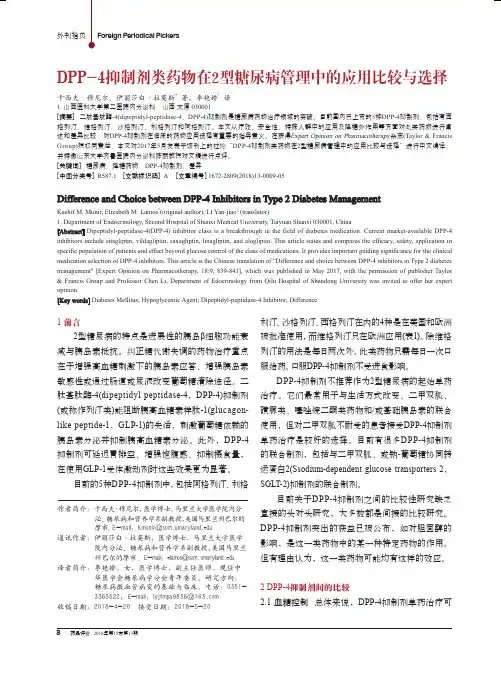
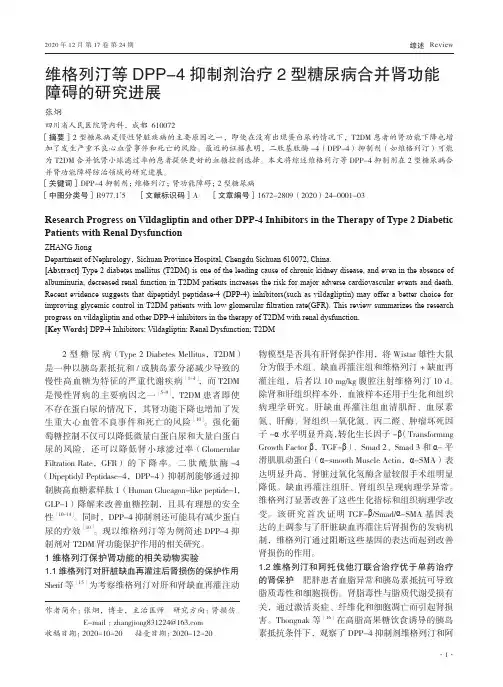
2020年12月 第17卷 第24期2型糖尿病(Type 2 Diabetes Mellitus,T2DM)是一种以胰岛素抵抗和/或胰岛素分泌减少导致的慢性高血糖为特征的严重代谢疾病[1-4],而T2DM 是慢性肾病的主要病因之一[5-9],T2DM患者即使不存在蛋白尿的情况下,其肾功能下降也增加了发生重大心血管不良事件和死亡的风险[10]。
强化葡萄糖控制不仅可以降低微量白蛋白尿和大量白蛋白尿的风险,还可以降低肾小球滤过率(Glomerular Filtration Rate,GFR)的下降率。
二肽酰肽酶-4(Dipeptidyl Peptidase-4,DPP-4)抑制剂能够通过抑制胰高血糖素样肽 1(Human Glucagon-like peptide-1, GLP-1)降解来改善血糖控制,且具有理想的安全性[10-14]。
同时,DPP-4抑制剂还可能具有减少蛋白尿的疗效[10]。
现以维格列汀等为例简述DPP-4抑制剂对T2DM肾功能保护作用的相关研究。
1 维格列汀保护肾功能的相关动物实验1.1 维格列汀对肝脏缺血再灌注后肾损伤的保护作用Sherif等[15]为考察维格列汀对肝和肾缺血再灌注动物模型是否具有肝肾保护作用,将Wistar雄性大鼠分为假手术组、缺血再灌注组和维格列汀+缺血再灌注组,后者以10 mg/kg腹腔注射维格列汀10 d。
除肾和肝组织样本外,血液样本还用于生化和组织病理学研究。
肝缺血再灌注组血清肌酐、血尿素氮、肝酶、肾组织一氧化氮、丙二醛、肿瘤坏死因子-α水平明显升高,转化生长因子-β(Transforming Growth Factor β,TGF-β)、Smad 2、Smad 3和α-平滑肌肌动蛋白(α-smooth Muscle Actin,α-SMA)表达明显升高,肾脏过氧化氢酶含量较假手术组明显降低。
缺血再灌注组肝、肾组织呈现病理学异常。
维格列汀显著改善了这些生化指标和组织病理学改变。
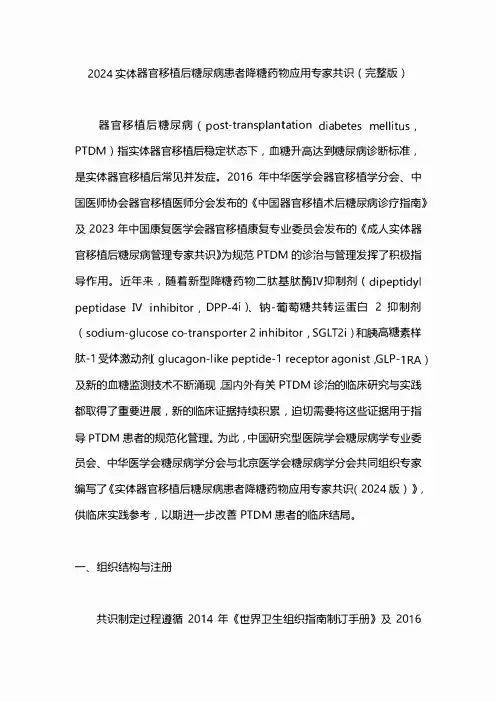
2024实体器官移植后糖尿病患者降糖药物应用专家共识(完整版)器官移植后糖尿病(po st-transplantation diabetes mellitus,P TDM)指实体器官移植后稳定状态下,血糖升高达到糖尿病诊断标准,是实体器官移植后常见并发症。
2016年中华医学会器官移植学分会、中国医师协会器官移植医师分会发布的《中国器官移植术后糖尿病诊疗指南》及2023年中国康复医学会器官移植康复专业委员会发布的《成人实体器官移植后糖尿病管理专家共识》为规范P TDM的诊治与管理发挥了积极指导作用。
近年来,随着新型降糖药物二肤基肤酶IV抑制剂(dipeptidyl peptidase IV inhibitor, DPP-4i)、钠葡萄糖共转运蛋白2抑制剂(sodium-glucose co-transporter 2 inhibitor, SGLT2i)和胰高糖素样肤-1受体激动剂glucagon-like peptide-1 receptor agonist,GLP-1 RA) 及新的血糖监测技术不断涌现,国内外有关PTDM诊治的临床研究与实践都取得了重要进展,新的临床证据持续积累,迫切需要将这些证据用千指导PTDM患者的规范化管理为此,中国研究型医院学会糖尿病学专业委员会、中华医学会糖尿病学分会与北京医学会糖尿病学分会共同组织专家编写了《实体器官移植后糖尿病患者降糖药物应用专家共识(2024版)》,供临床实践参考,以期进一步改善P TDM患者的临床结局。
一、组织结构与注册共识制定过程遵循2014年《世界卫生组织指南制订手册》及2016年发布的《制订/修订<临床诊疗指南>的基本方法及程序》,参照《中国制订/修订临床诊疗指南的指导原则(2022版)》编写。
由中国研究型医院学会糖尿病学专业委员会中华医学会糖尿病学分会与北京医学会糖尿病学分会的主任委员牵头成立学术指导委员会、共识编写专家组与审阅专家组,上述委员会成员包括内分泌科、移植内科、移植外科、泌尿外科、肝胆外科等涉及器官移植随访管理的相关专家。
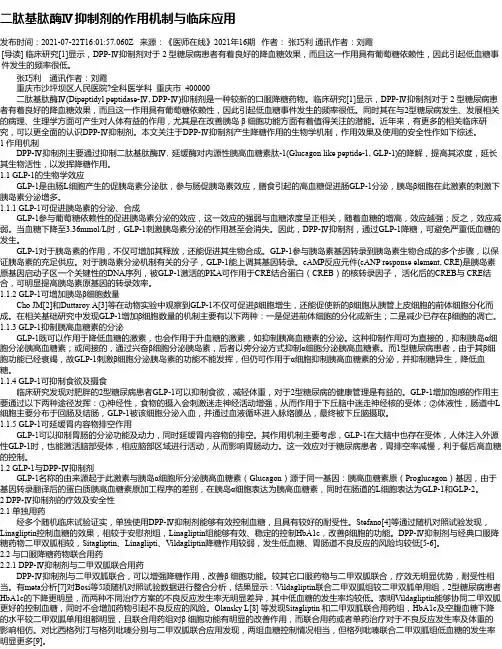
二肽基肽酶Ⅳ抑制剂的作用机制与临床应用发布时间:2021-07-22T16:01:57.060Z 来源:《医师在线》2021年16期作者:张巧利通讯作者:刘霞[导读] 临床研究[1]显示,DPP-Ⅳ抑制剂对于 2 型糖尿病患者有着良好的降血糖效果,而且这一作用具有葡萄糖依赖性,因此引起低血糖事件发生的频率很低。
张巧利通讯作者:刘霞重庆市沙坪坝区人民医院?全科医学科重庆市 400000 二肽基肽酶Ⅳ(Dipeptidyl peptidase-Ⅳ, DPP-Ⅳ)抑制剂是一种较新的口服降糖药物。
临床研究[1]显示,DPP-Ⅳ抑制剂对于 2 型糖尿病患者有着良好的降血糖效果,而且这一作用具有葡萄糖依赖性,因此引起低血糖事件发生的频率很低。
同时其在与2型糖尿病发生、发展相关的病理、生理学方面可产生对人体有益的作用,尤其是在改善胰岛 β 细胞功能方面有着值得关注的潜能。
近年来,有更多的相关临床研究,可以更全面的认识DPP-Ⅳ抑制剂。
本文关注于DPP-Ⅳ抑制剂产生降糖作用的生物学机制,作用效果及使用的安全性作如下综述。
1 作用机制DPP-Ⅳ抑制剂主要通过抑制二肽基肽酶Ⅳ,延缓酶对内源性胰高血糖素肽-1(Glucagon like peptide-1, GLP-1)的降解,提高其浓度,延长其生物活性,以发挥降糖作用。
1.1 GLP-1的生物学效应 GLP-1是由肠L细胞产生的促胰岛素分泌肽,参与肠促胰岛素效应,膳食引起的高血糖促进肠GLP-1分泌,胰岛β细胞在此激素的刺激下胰岛素分泌增多。
1.1.1 GLP-1可促进胰岛素的分泌、合成 GLP-1参与葡萄糖依赖性的促进胰岛素分泌的效应,这一效应的强弱与血糖浓度呈正相关,随着血糖的增高,效应越强;反之,效应减弱。
当血糖下降至3.36mmol/L时,GLP-1刺激胰岛素分泌的作用甚至会消失。
因此,DPP-Ⅳ抑制剂,通过GLP-1降糖,可避免严重低血糖的发生。
GLP-1对于胰岛素的作用,不仅可增加其释放,还能促进其生物合成。
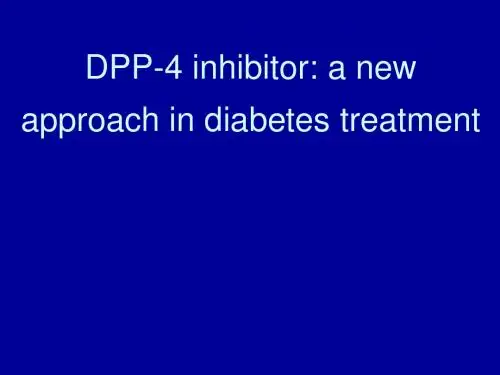
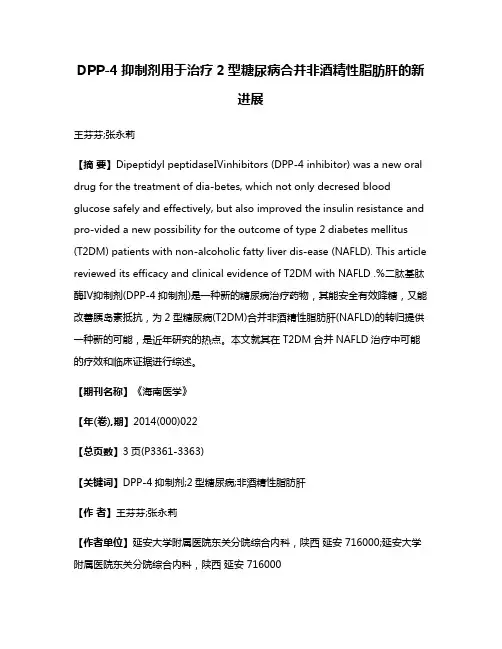
DPP-4抑制剂用于治疗2型糖尿病合并非酒精性脂肪肝的新进展王芬芬;张永莉【摘要】Dipeptidyl peptidaseⅣinhibitors (DPP-4 inhibitor) was a new oral drug for the treatment of dia-betes, which not only decresed blood glucose safely and effectively, but also improved the insulin resistance and pro-vided a new possibility for the outcome of type 2 diabetes mellitus (T2DM) patients with non-alcoholic fatty liver dis-ease (NAFLD). This article reviewed its efficacy and clinical evidence of T2DM with NAFLD .%二肽基肽酶Ⅳ抑制剂(DPP-4抑制剂)是一种新的糖尿病治疗药物,其能安全有效降糖,又能改善胰岛素抵抗,为2型糖尿病(T2DM)合并非酒精性脂肪肝(NAFLD)的转归提供一种新的可能,是近年研究的热点。
本文就其在T2DM合并NAFLD治疗中可能的疗效和临床证据进行综述。
【期刊名称】《海南医学》【年(卷),期】2014(000)022【总页数】3页(P3361-3363)【关键词】DPP-4抑制剂;2型糖尿病;非酒精性脂肪肝【作者】王芬芬;张永莉【作者单位】延安大学附属医院东关分院综合内科,陕西延安 716000;延安大学附属医院东关分院综合内科,陕西延安 716000【正文语种】中文【中图分类】R587.1随着人民生活水平的提高、生活方式及饮食结构的改变,2型糖尿病(T2DM)的发病率迅速增长,T2DM患者合并非酒精性脂肪肝(NAFLD)的发病率也呈明显的上升趋势。
![[2012ADA专家访谈]吡格列酮治疗糖尿病的风险与获益](https://uimg.taocdn.com/0c7f26b0fd0a79563c1e72cd.webp)
[2012ADA专家访谈]吡格列酮治疗糖尿病的风险与获益——StevenE.Nissen教授专访作者:admin 来源:国际糖尿病点击数: 9 更新时间:2012年07月05日【字体:大中小】内容概要:Nissen教授:在当前所有种类的降糖药物中,TZD类药物的降糖作用是最持久的,吡格列酮也是如此。
患者应用吡格列酮后很多年血糖都控制得很好。
我们最长研究了5年。
很多有吡格列酮应用经验的患者告诉我,用药超过5年时效果还很不错。
除了吡格列酮之外,目前还没有其他药物被证实降糖作用可以维持这么久。
Steven Nissen ACC前任主席,美国克利夫兰临床中心心血管医学部主任<International Diabetes>: One adverse effect that is a hot topic concerning pio glitazone is bladder cancer. Can you address that issue?Prof. Nissen: I am just not convinced that there is an effect. The studies that have led to this conclusion are weak and inconclusive and some of them ac tually go in different directions. Out just today is a long-term analysis from the Kaiser Permanente System that shows a hazard ratio for bladder cancer of 0. 98, which essentially is neutral. I think the jury is still out on bladder can cer. If it does occur it occurs at such a low rate as to not be a very signific ant concern in relation to the cardiovascular benefit.《国际糖尿病》:有关吡格列酮的不良反应,大家比较关注的是膀胱癌。
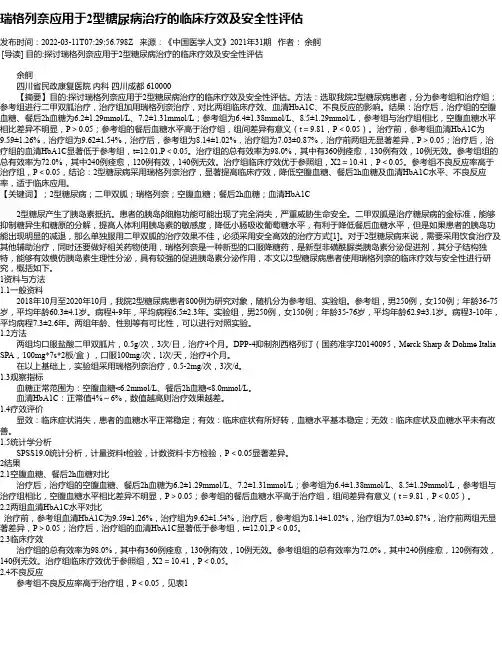
瑞格列奈应用于2型糖尿病治疗的临床疗效及安全性评估发布时间:2022-03-11T07:29:56.798Z 来源:《中国医学人文》2021年31期作者:余舸[导读] 目的:探讨瑞格列奈应用于2型糖尿病治疗的临床疗效及安全性评估余舸四川省民政康复医院内科四川成都 610000 【摘要】目的:探讨瑞格列奈应用于2型糖尿病治疗的临床疗效及安全性评估。
方法:选取我院2型糖尿病患者,分为参考组和治疗组;参考组进行二甲双胍治疗,治疗组加用瑞格列奈治疗,对比两组临床疗效、血清HbA1C、不良反应的影响。
结果:治疗后,治疗组的空腹血糖、餐后2h血糖为6.2±1.29mmol/L、7.2±1.31mmol/L;参考组为6.4±1.38mmol/L、8.5±1.29mmol/L,参考组与治疗组相比,空腹血糖水平相比差异不明显,P>0.05;参考组的餐后血糖水平高于治疗组,组间差异有意义(t=9.81,P<0.05)。
治疗前,参考组血清HbA1C为9.59±1.26%,治疗组为9.62±1.54%,治疗后,参考组为8.14±1.02%,治疗组为7.03±0.87%,治疗前两组无显著差异,P>0.05;治疗后,治疗组的血清HbA1C显著低于参考组,t=12.01,P<0.05。
治疗组的总有效率为98.0%,其中有360例痊愈,130例有效,10例无效。
参考组组的总有效率为72.0%,其中240例痊愈,120例有效,140例无效。
治疗组临床疗效优于参照组,X2=10.41,P<0.05。
参考组不良反应率高于治疗组,P<0.05,结论:2型糖尿病采用瑞格列奈治疗,显著提高临床疗效,降低空腹血糖、餐后2h血糖及血清HbA1C水平、不良反应率,适于临床应用。
【关键词】;2型糖尿病;二甲双胍;瑞格列奈;空腹血糖;餐后2h血糖;血清HbA1C2型糖尿产生了胰岛素抵抗。
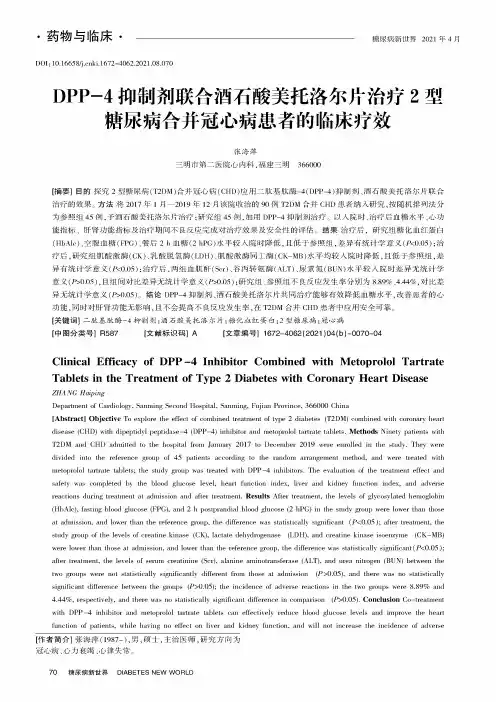
DOI:10.16658/ki.1672-4062.2021.08.070DPP-4抑制剂联合酒石酸美托洛尔片治疗2型糖尿病合并冠心病患者的临床疗效张海萍三明市第二医院心内科,福建三明366000[摘要]目的探究2型糖尿病(T2DM)合并冠心病(CHD)应用二肽基肽酶-4(DPP-4)抑制剂、酒石酸美托洛尔片联合治疗的效果。
方法将2017年1月一2019年12月该院收治的90例T2DM合并CHD患者纳入研究,按随机排列法分为参照组45例,予酒石酸美托洛尔片治疗;研究组45例,加用DPP-4抑制剂治疗。
以入院时、治疗后血糖水平、心功能指标、肝肾功能指标及治疗期间不良反应完成对治疗效果及安全性的评估。
结果治疗后,研究组糖化血红蛋白(HbAlc)、空腹血糖(FPG)、餐后2h血糖(2hPG)水平较入院时降低,且低于参照组,差异有统计学意义(P<0.05);治疗后,研究组肌酸激酶(CK)、乳酸脱氢酶(LDH)、肌酸激酶同工酶(CK-MB)水平均较入院时降低,且低于参照组,差异有统计学意义(P<0.05);治疗后,两组血肌酐(Scr)、谷丙转氨酶(ALT)、尿素氮(BUN)水平较入院时差异无统计学意义(P>0.05),且组间对比差异无统计学意义(P>0.05);研究组、参照组不良反应发生率分别为&89%、4.44%,对比差异无统计学意义(P>0.05)。
结论DPP-4抑制剂、酒石酸美托洛尔片共同治疗能够有效降低血糖水平,改善患者的心功能,同时对肝肾功能无影响,且不会提高不良反应发生率,在T2DM合并CHD患者中应用安全可靠。
[关键词]二肽基肽酶-4抑制剂;酒石酸美托洛尔片;糖化血红蛋白;2型糖尿病;冠心病[中图分类号]R587[文献标识码]A[文章编号]1672-4062(2021)04(b)-0070-04Clinical Efficacy of DPP-4Inhibitor Combined with Metoprolol Tartrate Tablets in the Treatment of Type2Diabetes with Coronary Heart Disease ZHANG HaipingDepartment of Cardiology,Sanming Second Hospital,Sanming,Fujian Province,366000China[Abstract]Objective To explore the effect of combined treatment of type2diabetes(T2DM)combined with coronary heart disease(CHD)with dipeptidyl peptidase-4(DPP-4)inhibitor and metoprolol tartrate tablets.Methods Ninety patients with T2DM and CHD admitted to the hospital from January2017to December2019were enrolled in the study.They were divided into the reference group of45patients according to the random arrangement method,and were treated with metoprolol tartrate tablets;the study group was treated with DPP-4inhibitors.The evaluation of the treatment effect and safety was completed by the blood glucose level,heart function index,liver and kidney function index,and adverse reactions during treatment at admission and after treatment.Results After treatment,the levels of glycosylated hemoglobin (HbAlc),fasting blood glucose(FPG),and2h postprandial blood glucose(2hPG)in the study group were lower than those at admission,and lower than the reference group,the difference was statistically significant(P<0.05);after treatment,the study group of the levels of creatine kinase(CK),lactate dehydrogenase(LDH),and creatine kinase isoenzyme(CK-MB) were lower than those at admission,and lower than the reference group,the difference was statistically significant(P<0.05);after treatment,the levels of serum creatinine(Scr),alanine aminotransferase(ALT),and urea nitrogen(BUN)between the two groups were not statistically significantly different from those at admission(P>0.05),and there was no statistically significant difference between the groups(P>0.05);the incidence of adverse reactions in the two groups were8.89%and4.44%,respectively,and there was no statistically significant difference in comparison(P>0.05).Conclusion Co-treatmentwith DPP-4inhibitor and metoprolol tartrate tablets can effectively reduce blood glucose levels and improve the heart function of patients,while having no effect on liver and kidney function,and will not increase the incidence of adverse [作者简介]张海萍(1987-),男,硕士,主治医师,研究方向为冠心病、心力衰竭、心律失常。
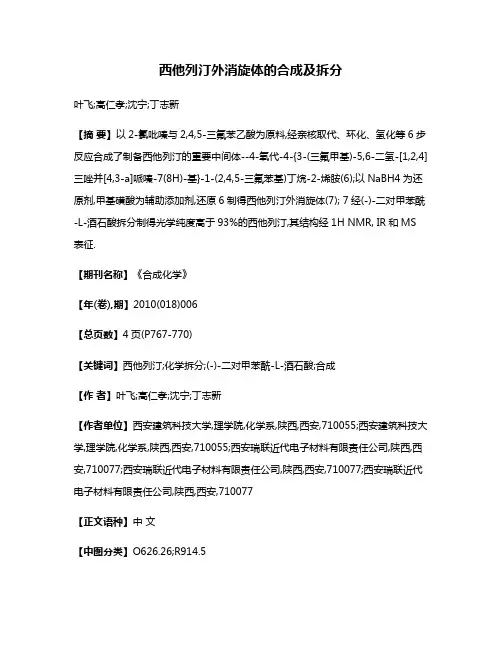
西他列汀外消旋体的合成及拆分叶飞;高仁孝;沈宁;丁志新【摘要】以2-氯吡嗪与2,4,5-三氟苯乙酸为原料,经亲核取代、环化、氢化等6步反应合成了制备西他列汀的重要中间体--4-氧代-4-{3-(三氟甲基)-5,6-二氢-[1,2,4]三唑并[4,3-a]哌嗪-7(8H)-基}-1-(2,4,5-三氟苯基)丁烷-2-烯胺(6);以NaBH4为还原剂,甲基磺酸为辅助添加剂,还原6制得西他列汀外消旋体(7); 7经(-)-二对甲苯酰-L-酒石酸拆分制得光学纯度高于93%的西他列汀,其结构经1H NMR, IR和MS 表征.【期刊名称】《合成化学》【年(卷),期】2010(018)006【总页数】4页(P767-770)【关键词】西他列汀;化学拆分;(-)-二对甲苯酰-L-酒石酸;合成【作者】叶飞;高仁孝;沈宁;丁志新【作者单位】西安建筑科技大学,理学院,化学系,陕西,西安,710055;西安建筑科技大学,理学院,化学系,陕西,西安,710055;西安瑞联近代电子材料有限责任公司,陕西,西安,710077;西安瑞联近代电子材料有限责任公司,陕西,西安,710077;西安瑞联近代电子材料有限责任公司,陕西,西安,710077【正文语种】中文【中图分类】O626.26;R914.5西他列汀{8,化学名7-[(3R)-3-氨基-1-氧-4-(2,4,5-三氟苯基)丁基]-3-三氟甲基-5,6,7,8-四氢[1,2,4]三唑并[4,3-a]哌嗪磷酸水合物}是默克公司研发并于2006年经美国食品药品管理局批准,用于治疗Ⅱ型糖尿病的首个DDP-Ⅳ抑制剂,其商品名为Januvia。
8主要通过保护胰高血糖素样肽-1(GLP-1)和肠抑胃肽(GIP)以达到治疗糖尿病的目的[1]。
Scott等[2]的研究显示,8具有良好的耐药性和安全性。
8的合成方法较多,工业上主要采用默克公司[3~6]的最新方法:以[(COD)RhCl]2和Josiphos SL-J002-1为手性催化剂不对称氢化烯胺(氢化转化率82%~89%, ee 值89%~95%);再与磷酸生成8的磷酸盐。
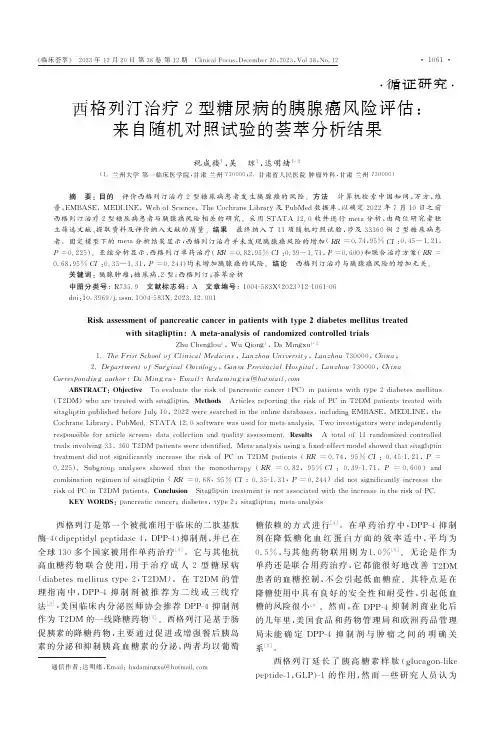
㊃循证研究㊃通信作者:达明绪,E m a i l :h x d a m i n gx u @h o t m a i l .c o m 西格列汀治疗2型糖尿病的胰腺癌风险评估:来自随机对照试验的荟萃分析结果祝成楼1,吴 琼1,达明绪1,2(1.兰州大学第一临床医学院,甘肃兰州730000;2.甘肃省人民医院肿瘤外科,甘肃兰州730000) 摘 要:目的 评价西格列汀治疗2型糖尿病患者发生胰腺癌的风险㊂方法 计算机检索中国知网,万方,维普,E M B A S E ,M E D L I N E ,W e bo f S c i e n c e ,T h eC o c h r a n eL i b r a r y 及Pu b M e d 数据库,以确定2022年7月10日之前西格列汀治疗2型糖尿病患者与胰腺癌风险相关的研究㊂采用S T A T A12.0软件进行m e t a 分析,由两位研究者独立筛选文献㊁提取资料及评价纳入文献的质量㊂结果 最终纳入了11项随机对照试验,涉及33360例2型糖尿病患者㊂固定模型下的m e t a 分析结果显示,西格列汀治疗并未发现胰腺癌风险的增加(R R =0.74,95%C I :0.45~1.21,P =0.225)㊂亚组分析显示,西格列汀单药治疗(R R =0.82,95%C I :0.39~1.71,P =0.600)和联合治疗方案(R R =0.68,95%C I :0.35~1.31,P =0.244)均未增加胰腺癌的风险㊂结论 西格列汀治疗与胰腺癌风险的增加无关㊂关键词:胰腺肿瘤;糖尿病,2型;西格列汀;荟萃分析中图分类号:R 735.9 文献标志码:A 文章编号:1004-583X (2023)12-1061-06d o i :10.3969/j.i s s n .1004-583X.2023.12.001R i s ka s s e s s m e n t o f p a n c r e a t i c c a n c e r i n p a t i e n t sw i t h t y pe 2d i a b e t e sm e l l i t u s t r e a t e d w i t h s i t a g l i p t i n :A m e t a -a n a l ys i s o f r a n d o m i z e d c o n t r o l l e d t r i a l s Z h uC h e n g l o u 1,W uQ i o n g 1,D aM i n gx u 1,21.T h eF r i s t S c h o o l o f C l i n i c a lM e d i c i n e ,L a n z h o uU n i v e r s i t y ,L a n z h o u 730000,C h i n a ;2.D e p a r t m e n t o f S u r g i c a lO n c o l o g y ,G a n s uP r o v i n c i a lH o s pi t a l ,L a n z h o u 730000,C h i n a C o r r e s p o n d i n g a u t h o r :D a M i n g x u ,E m a i l :h x d a m i n gx u @h o t m a i l .c o m A B S T R A C T :O b je c t i v e T oe v a l u a t e t h e r i s kof p a n c r e a t i cc a n c e r (P C )i n p a t i e n t sw i t ht y p e2d i a b e t e sm e l l i t u s (T 2D M )w h o a r e t r e a t e dw i t hs i t ag l i p t i n .M e th o d s A r ti c l e s r e p o r t i n g th e r i s ko fP Ci nT 2D M p a t i e n t s t r e a t e dw i t h s i t a g l i p t i n p u b l i s h e db e f o r e J u l y 10,2022w e r e s e a r c h e d i n t h e o n l i n e d a t a b a s e s ,i n c l u d i n g E M BA S E ,M E D L I N E ,t h e C o c h r a n eL i b r a r y ,P u b M e d .S T A T A12.0s o f t w a r ew a s u s e d f o rm e t a -a n a l y s i s .T w o i n v e s t i g a t o r sw e r e i n d e p e n d e n t l y r e s p o n s i b l ef o ra r t i c l es c r e e n ,d a t ac o l l e c t i o na n d q u a l i t y as s e s s m e n t .R e s u l t s At o t a lo f11r a n d o m i z e dc o n t r o l l e d t r i a l s i n v o l v i n g 33,360T 2D M p a t i e n t sw e r e i d e n t i f i e d .M e t a -a n a l y s i s u s i n g a f i x e d -e f f e c tm o d e l s h o w e d t h a t s i t a g l i p t i n t r e a t m e n t d i dn o ts i g n i f i c a n t l y i n c r e a s et h er i s ko fP Ci n T 2D M p a t i e n t s (R R =0.74,95%C I :0.45-1.21,P =0.225).S u b g r o u p a n a l y s e ss h o w e dt h a tt h e m o n o t h e r a p y (R R =0.82,95%C I :0.39-1.71,P =0.600)a n d c o m b i n a t i o n r e g i m e no f s i t a g l i p t i n (R R =0.68,95%C I :0.35-1.31,P =0.244)d i dn o t s i g n i f i c a n t l y in c r e a s e t h e r i s ko fP C i nT 2D M p a t i e n t s .C o n c l u s i o n S i t a g l i pt i n t r e a t m e n t i sn o t a s s o c i a t e dw i t h t h e i n c r e a s e i n t h e r i s ko fP C .K E Y W O R D S :p a n c r e a t i c c a n c e r ;d i a b e t e s ,t y p e 2;s i t a g l i p t i n ;m e t a -a n a l y s i s 西格列汀是第一个被批准用于临床的二肽基肽酶-4(d i p e p t i d y l p e pt i d a s e 4,D P P -4)抑制剂,并已在全球130多个国家被用作单药治疗[1]㊂它与其他抗高血糖药物联合使用,用于治疗成人2型糖尿病(d i a b e t e sm e l l i t u s t y pe2,T 2D M )㊂在T 2D M 的管理指南中,D P P -4抑制剂被推荐为二线或三线疗法[2],美国临床内分泌医师协会推荐D P P -4抑制剂作为T 2D M 的一线降糖药物[3]㊂西格列汀是基于肠促胰素的降糖药物,主要通过促进或增强餐后胰岛素的分泌和抑制胰高血糖素的分泌,两者均以葡萄糖依赖的方式进行[4]㊂在单药治疗中,D P P -4抑制剂在降低糖化血红蛋白方面的效率适中,平均为0.5%,与其他药物联用则为1.0%[5]㊂无论是作为单药还是联合用药治疗,它都能很好地改善T 2D M患者的血糖控制,不会引起低血糖症㊂其特点是在降糖使用中具有良好的安全性和耐受性,引起低血糖的风险很小[6]㊂然而,在D P P -4抑制剂商业化后的几年里,美国食品和药物管理局和欧洲药品管理局未能确定D P P -4抑制剂与肿瘤之间的明确关系[7]㊂西格列汀延长了胰高糖素样肽(g l u c a g o n -l i k e p e p t i d e -1,G L P )-1的作用,然而一些研究人员认为㊃1601㊃‘临床荟萃“ 2023年12月20日第38卷第12期 C l i n i c a l F o c u s ,D e c e m b e r 20,2023,V o l 38,N o .12D P P-4抑制剂也可能增加致癌的风险㊂G L P-2是由末端回肠和结肠的L细胞分泌的一种肠道营养性生长因子[8],在胃肠道中具有强大的抗凋亡作用,D P P-4能迅速降解并使G L P-2失活;同时D P P-4还参与肿瘤进展的其他趋化因子的失活,如C X C L5㊁C X C L12及S D F-1,因此长期使用D P P-4可能会加速一些肿瘤的发生,特别是增加胰腺炎和胰腺癌的潜在风险[9]㊂然而,一些研究也显示,它们之间没有显著的关联㊂总体而言,西格列汀与胰腺癌之间的关系尚未确定㊂本研究旨在单独评估西格列汀与胰腺癌风险增加是否相关,并为T2D M患者的药物选择提供参考和指导㊂1资料与方法1.1检索策略为了纳入有关T2D M患者使用西格列汀治疗的胰腺癌风险的研究,我们在2022年7月10日之前进行了全面的数据库检索,包括中国知网㊁万方㊁维普㊁E M B A S E㊁M E D L I N E㊁W e bo f S c i e n c e㊁T h eC o c h r a n eL i b r a r y及P u b M e d数据库㊂文献检索词如下: D P P-4I n h i b i t o r , D P P-I V I n h i b i t o r , D i p e p t i d y l P e p t i d a s e4I n h i b i t o r , D i p e p t i d y l P e p t i d a s eI V I n h i b i t o r , p a n c r e a t i c c a n c e r , P a n c r e a t i c N e o p l a s m , C a n c e r o f P a n c r e a s , P a n c r e a t i cD u c t a l C a r c i n o m a s , P C , s i t a g l i p t i n , MK0431 ㊂1.2纳入标准及排除标准纳入标准:(1)随机对照试验(r a n d o m i z e dc l i n i c a l t r i a l,R C T);(2)研究必须包括使用西格列汀治疗T2D M患者的干预组㊂(3)T2D M患者必须进行最后24周的治疗研究;(4)获取不良事件报告的信息,胰腺癌的发生率是否为主要终点指标;(5)完整的研究以英文发表㊂排除标准:(1)重复研究;(2)会议摘要㊁病例报告㊁通信㊁综述等非R C T研究;(3)无全文;(4)全文未报道生存结果等㊂1.3文献筛选与资料提取相关数据由2位研究者独立地从纳入的研究中提取,如遇分歧,则讨论协商解决或相关专家协助判断㊂提取资料如下:(1)研究发表特征包括第一作者㊁发表年份㊁样本量㊁所在国家㊁干预方案㊁试验时间;(2)纳入研究设计类型;(3)临床结果:发病率数据㊂对于缺乏资料的文献,研究者会与原作者取得联系并加以补充㊂1.4纳入文献的质量评价由两位评价员独立使用C o c h r a n e工具对R C T进行偏倚评估㊂我们在以下方面评估了研究的可靠性:随机序列生成和分配的隐蔽性㊁对参与者和结果的盲法㊁不完整的结果数据㊁评估选择性结果报告和其他偏倚㊂1.5统计学方法使用S T A T A12.0版本来进行数据分析㊂纳入研究之间的异质性采用基于I2的Q 检验进行评估:如果Pȡ0.1或I2ɤ50%,则采用固定效应模型对H R及其95%C I进行汇总;如果P< 0.1或I2>50%,则采用随机效应模型㊂根据干预方案进行亚组分析㊂漏斗图用于测量潜在发表文章的偏倚㊂敏感性分析用于解决纳入文献的异质性㊂2结果2.1文献筛选流程及纳入研究特征所有296项研究均被筛选,其中11项研究[10-20]符合条件,共计T2D M患者33360例㊂见图1㊂纳入的11项研究中,每一项都有来自C o c h r a n e 工具的评价结果,均无高偏倚风险,见表1㊂图1文献筛选流程及结果F i g.1 P r o c e s s a n d r e s u l t o f l i t e r a t u r e s c r e e n i n g2.2西格列汀治疗胰腺癌的风险评估采用固定效应模型进行m e t a分析,结果显示西格列汀治疗未发现胰腺癌风险增加(R R=0.74,95%C I:0.45~ 1.21,P=0.225)㊂见图2㊂亚组分析显示,西格列汀单药治疗(R R=0.82,95%C I:0.39~1.71,P=0.600)和联合治疗(R R=0.68,95%C I:0.35~1.31,P=0.244)均未增加胰腺癌的风险㊂见图3㊂2.3发表偏倚及敏感性分析漏斗图显示没有发表偏倚,见图4㊂敏感度分析显示,单独剔除本m e t a 分析所纳入的11篇文献中任何一篇文献后,对m e t a 分析结果无明显影响,见图5㊂㊃2601㊃‘临床荟萃“2023年12月20日第38卷第12期 C l i n i c a l F o c u s,D e c e m b e r20,2023,V o l38,N o.12表1 纳入文献的基本特征T a b .1 B a s i c c h a r a c t e r i s t i c s o f i n c l u d e d l i t e r a t u r e s第一作者国家类型治疗方案干预组对照组样本量(P C e v e n t s )疗程(周)C h a r b o n n e l [10],2006法国R C T 西格列汀+安慰剂格列吡嗪+安慰剂464(1)v s 237(0)104R a z [11],2006以色列R C T 西格列汀+安慰剂吡格列酮+安慰剂411(0)v s 110(1)54C h a n [12],2008中国R C T 西格列汀安慰剂65(1)v s 26(0)54G o l d s t e i n [13],2007美国R C T 西格列汀+二甲双胍二甲双胍182(0)v s 176(1)24R a z [14],2008以色列R C T 西格列汀+二甲双胍安慰剂+二甲双胍96(0)v s 94(1)30A r e c h a v a l e t a [15],2011墨西哥R C T 西格列汀+二甲双胍格列美脲+二甲双胍516(1)v s 518(0)30A r j o n a [16],2013美国R C T 西格列汀格列美脲210(1)v s 212(0)54H e n r y [17],2014美国R C T 西格列汀+吡格列酮吡格列酮231(1)v s 233(0)54L i n j a w i [18],2015阿根廷R C T 胰岛素+西格列汀+二甲双胍胰岛素+二甲双胍193(1)v s 192(0)24G r e e n [19],2015美国R C T 西格列汀安慰剂7257(9)v s 7266(14)260B u s e [20],2017美国R C T西格列汀安慰剂7332(9)v s 7339(14)144注:P C e v e n t s:胰腺癌发生事件图2 西格列汀与对照组胰腺癌风险的m e t a 分析结果F i g .2 M e t a -a n a l y s i s r e s u l t s o f t h e r i s ko f P C f o r s i t a g l i p t i nv e r s u s o t h e r c o m p a r a t o rs 图3 胰腺癌与西格列汀风险关系的亚组分析(干预方案)F i g.3 S u b g r o u p a n a l y s i s o f r i s k r e l a t i o n s h i p b e t w e e nP Ca n d s i t a g l i p t i n (I n t e r v e n t i o n p r o g r a m )㊃3601㊃‘临床荟萃“ 2023年12月20日第38卷第12期 C l i n i c a l F o c u s ,D e c e m b e r 20,2023,V o l 38,N o .12图4 纳入研究的漏斗图分析F i g.4 F u n n e l p l o t a n a l y s i s o f t h e i n c l u d e d s t u d i es 图5 以P C 为结局的敏感性分析F i g.5 S e n s i t i v i t y a n a l y s i sw i t hP Ca s t h e e n d p o i n t 3 讨 论大量的随机安慰剂或对照试验已经证明了西格列汀在改善T 2M D 患者血糖控制方面的疗效㊂西格列汀通常耐受性良好,大多数不良事件为轻度至中度,患者因这些事件而停止治疗相对较少㊂因此,它仍然是治疗T 2M D 患者的一个重要选择㊂先前的有关研究报道了西格列汀增加胰腺癌风险的可能性㊂有研究指出,使用西格列汀或艾塞那肽(抵抗D P P -4降解的G L P -1激动剂)中任何一种的患者出现胰腺炎的不良事件事件发生率增加了6倍以上[21],而由于胰腺炎是胰腺癌的危险因素[22],使用西格列汀后胰腺癌的发生率是其他治疗的2.7倍,此外,D P P -4抑制剂长期激活G L P -1受体也可能导致胰腺癌风险增加㊂另一项回顾性研究也显示,使用西格列汀总体上增加了胰腺癌的风险,特别是当西格列汀的累积剂量<33700m g 时,风险显著增㊃4601㊃‘临床荟萃“ 2023年12月20日第38卷第12期 C l i n i c a l F o c u s ,D e c e m b e r 20,2023,V o l 38,N o .12加;相反,累积剂量越高的使用者患胰腺癌风险可能越低[23]㊂也有研究推测抑制D P P-4的免疫调节作用可能会增加所有癌症的风险[24]㊂而本荟萃分析结果提示,西格列汀与其他干预措施之间的胰腺癌发生率并无差异(R R=0.74,95%C I:0.45~1.21,P= 0.225)㊂有学者在动物实验中观察到西格列汀可以纠正潜在的代谢障碍㊁炎症和氧化应激,长期使用患胰腺癌的风险可能会降低[25]㊂有临床实验证明,与磺脲类或噻唑烷二酮类药物相比,使用D P P-4抑制剂的胰腺癌风险并未增加[26]㊂另外,有报道阐述了新发D M患者患胰腺癌的风险极高,是胰腺癌的早期征兆[27],没有明确的证据表明所纳入文献中的R C T招募了患胰腺癌风险较高的患者,故服用西格列汀的患者发生胰腺癌的原因难以得到定论㊂有报道称二甲双胍可以降低患胰腺癌的风险[28],为避免纳入研究中西格列汀与二甲双胍联用会消除患胰腺癌的风险所带来的偏倚,我们进行了亚组分析,结果表明,无论是西格列汀单药治疗(R R= 0.82,95%C I:0.39~1.71,P=0.600)还是联合治疗方案(R R=0.68,95%C I:0.35~1.31,P= 0.244)均未增加胰腺癌的风险㊂由于所有符合条件的R C T中胰腺癌的发生仅仅作为不良事件被报道,这也是本研究的一项局限性,且试验持续时间有限,可能由于时间太短而无法检测到对癌症发生的影响,可能低估了胰腺癌的实际发生率㊂总之,现有数据不支持西格列汀在治疗T2D M 时会增加胰腺癌的发病风险,但目前的数据尚不足以得出明确的结论,有关西格列汀与胰腺癌之间的关系,还需大量的相关临床试验来佐证㊂本荟萃分析存在局限性:(1)在所有符合条件的R C T中均没有特定的胰腺癌诊断标准㊂(2)报道的胰腺癌风险包括腺癌和神经内分泌肿瘤,但由于R C T提供的肿瘤分类信息有限,我们无法分析这两种类型的发生率㊂(3)当胰腺癌未被归类为特殊关注的不良事件时,我们只收集了报告为严重不良事件的病例,可能低估了其实际发生率㊂(4)尽管异质性较低,但当有许多试验和少数事件时,确定的可靠性是值得怀疑的㊂这项荟萃分析为西格列汀治疗增加胰腺癌风险的假说提供了可靠的证据㊂鉴于其潜在的致癌效力,迫切需要更大规模的长期胰腺安全监测,在缺乏R C T情况下,需要继续进行流行病学研究以进行长期监测㊂参考文献:[1]S c o t tL J.S i t a g l i p t i n:Ar e v i e wi n t y p e2d i a b e t e s[J].D r u g s,2017,77(2):209-224.[2] Q a s e e m A,B a r r y M J,H u m p h r e y L L,e t a l.O r a lp h a r m a c o l o g i c t r e a t m e n t o f t y p e2d i a b e t e sm e l l i t u s:Ac l i n i c a l p r a c t i c e g u i d e l i n e u p d a t e f r o m t h e A m e r i c a n c o l l e g e o f p h y s i c i a n s[J].A n n I n t e r n M e d,2017,166(4):279-290.[3] G a r b e rA J,A b r a h a m s o n M J,B a r z i l a y J I,e ta l.C o n s e n s u ss t a t e m e n t b y t h e A m e r i c a n a s s o c i a t i o n o f c l i n i c a le n d o c r i n o l o g i s t s a n da m e r i c a nc o l l e g eof e n d o c r i n o l og y o nth ec o m p r e h e n s i v et y p e2d i a be t e s m a n a g e m e n ta l g o r i t h m-2017e x e c u t i v e s u mm a r y[J].E n d o c r P r a c t,2017,23(2):207-238.[4] M u l v i h i l lE E,D r u c k e r D J.P h a r m a c o l o g y,p h y s i o l o g y,a n dm e c h a n i s m so f a c t i o no fd i p e p t i d y l p e p t i d a s e-4i n h i b i t o r s[J].E n d o c rR e v,2014,35(6):992-1019.[5]S t o i a nA P,S a c h i n i d i sA,S t o i c aR A,e t a l.T h ee f f i c a c y a n ds a f e t y o fd i p e p t i d y l p e p t i d a s e-4i n h i b i t o r sc o m p a r e dt oo t h e r o r a l g l u c o s e-l o w e r i n g m e d i c a t i o n s i nt h et r e a t m e n to f t y p e2d i a be t e s[J].M e t a b o l i s m,2020,109:154295.[6]S c h e e nA J.T h e s a f e t y o f g l i p t i n s:U p d a t e dd a t a i n2018[J].E x p e r tO p i nD r u g S a f,2018,17(4):387-405.[7] E g a n A G,B l i n d E,D u n d e r K,e ta l.P a n c r e a t i cs a f e t y o fi n c r e t i n-b a s e dd r u g s-F D Aa n dE MAa s s e s s m e n t[J].N E n g l JM e d,2014,370(9):794-797.[8] D r u c k e rD J,Y u s t a B.P h y s i o l o g y a n d p h a r m a c o l o g y o ft h ee n t e r o e n d o c r i n eh o r m o n e g l u c a g o n-l i k e p e p t i d e-2[J].A n n uR e vP h y s i o l,2014,76:561-583.[9] F u j i w a r a K,I n o u e T,H e n m i Y,e t a l.S i t a g l i p t i n,ad i pe p t i d y l p e p t i d a s e-4i n h i b i t o r,s u p p r e s s e sC X C L5a n dS D F-1a n d d o e s n o t a c c e l e r a t e i n t e s t i n a l n e o p l a s i a f o r m a t i o n i nA p c M i n/+m i c e f e d ah i g h-f a t d i e t[J].O n c o l L e t t,2017,14(4):4355-4360.[10] C h a r b o n n e l B,K a r a s i kA,L i u J,e t a l.E f f i c a c y a n d s a f e t y o ft h e d i p e p t i d y l p e p t i d a s e-4i n h i b i t o r s i t a g l i p t i n a d d e d t o o n g o i n gm e t f o r m i n t h e r a p y i n p a t i e n t s w i t h t y p e2d i a b e t e si n a d e q u a t e l y c o n t r o l l e d w i t h m e t f o r m i n a l o n e[J].D i a b e t e sC a r e,2006,29(12):2638-2643.[11] R a z I,H a n e f e l d M,X uL,e ta l.E f f i c a c y a n ds a f e t y o f t h ed i pe p t i d y l p e p t i d a s e-4i n h i b i t o rs i t a g l i p t i na s m o n o t h e r a p y i np a t i e n t sw i t h t y p e2d i a b e t e sm e l l i t u s[J].D i a b e t o l o g i a,2006, 49(11):2564-2571.[12] C h a nJ C,S c o t t R,A r j o n a F e r r e i r aJ C,e ta l.S a f e t y a n de f f i c a c y o fs i t a g l i p t i ni n p a t i e n t s w i t h t y p e2d i a b e t e sa n dc h r o n i c r e n a l i n s u f f i c i e n c y[J].D i a b e t e sO b e sM e t a b,2008,10(7):545-555.[13] G o l d s t e i nB J,F e i n g l o s MN,L u n c e f o r dJ K,e ta l.E f f e c to fi n i t i a l c o m b i n a t i o n t h e r a p y w i t h s i t a g l i p t i n,a d i p e p t i d y lp e p t i d a s e-4i n h i b i t o r,a n d m e t f o r m i no n g l y c e m i cc o n t r o l i np a t i e n t sw i t h t y p e2d i a b e t e s[J].D i a b e t e s C a r e,2007,30(8): 1979-1987.[14] R a z I,C h e nY,W uM,e t a l.E f f i c a c y a n d s a f e t y o f s i t a g l i p t i na d d e d t oo n g o i n g m e t f o r m i nt h e r a p y i n p a t i e n t s w i t ht y p e2d i a be t e s[J].C u r rM e dR e sO p i n,2008,24(2):537-550.[15] A r e c h a v a l e t aR,S e c kT,C h e nY,e t a l.E f f i c a c y a n d s a f e t y o ft r e a t m e n tw i t h s i t a g l i p t i n o r g l i m e p i r i d e i n p a t i e n t sw i t h t y p e2㊃5601㊃‘临床荟萃“2023年12月20日第38卷第12期 C l i n i c a l F o c u s,D e c e m b e r20,2023,V o l38,N o.12d i a be t e s i n a d e q u a t e l y c o n t r o l l e do n m e tf o r m i n m o n o t h e r a p y:Ar a n d o m i z e d,d o u b l e-b l i n d,n o n-i n f e r i o r i t y t r i a l[J].D i a b e t e sO b e sM e t a b,2011,13(2):160-168.[16] A r j o n aF e r r e i r a J C,M a r r eM,B a r z i l a iN,e t a l.E f f i c a c y a n ds a f e t y o fs i t a g l i p t i n v e r s u s g l i p i z i d ei n p a t i e n t s w i t ht y p e2d i a be t e s a n dm o d e r a t e-t o-s e v e r e c h r o n i c r e n a l i n s uf f i c i e n c y[J].D i a b e t e sC a r e,2013,36(5):1067-1073.[17] H e n r y R R,S t a e l sB,F o n s e c aV A,e t a l.E f f i c a c y a n ds a f e t yo f i n i t i a l c o m b i n a t i o n t r e a t m e n t w i t h s i t a g l i p t i n a n dp i o g l i t a z o n e-a f a c t o r i a l s t u d y[J].D i a b e t e sO b e sM e t a b,2014, 16(3):223-230.[18] L i n j a w i S,S o t h i r a t n a m R,S a r iR,e t a l.T h es t u d y o f o n c e-a n dt w i c e-d a i l yb i p h a s i ci n s u l i na s p a r t30(B I A s p30)w i t hs i t a g l i p t i n,a n dt w i c e-d a i l y B I A s p30w i t h o u ts i t a g l i p t i n,i np a t i e n t sw i t ht y p e2d i a b e t e su n c o n t r o l l e do ns i t a g l i p t i na n dm e t f o r m i n-T h e S i t2M i x t r i a l[J].P r i mC a r eD i a b e t e s,2015,9(5):370-376.[19] G r e e nJ B,B e t h e l MA,A r m s t r o n g P W,e t a l.E f f e c t o fs i t a g l i p t i no n c a r d i o v a s c u l a r o u t c o m e s i n t y p e2d i a b e t e s[J].NE n g l JM e d,2015,373(3):232-242.[20] B u s e J B,B e t h e l MA,G r e e nJ B,e ta l.P a n c r e a t i cs a f e t y o fs i t a g l i p t i n i n t h eT E C O Ss t u d y[J].D i a b e t e sC a r e,2017,40(2):164-170.[21] E l a s h o f f M,M a t v e y e n k o A V,G i e rB,e ta l.P a n c r e a t i t i s,p a n c r e a t i c,a n dt h y r o i dc a n c e r w i t h g l u c a g o n-l i k e p e p t i d e-1-b a s e d t h e r a p i e s[J].G a s t r o e n t e r o l o g y,2011,141(1):150-156.[22] V l a v c h e s k iF,O'N e i l l E J,G a g a c e v F,e t a l.E f f e c t s o fb e r b e r i n ea g a i n s t p a nc r e a t i t i s a nd p a n c re a t i c c a n c e r[J].M o l e c u l e s,2022,27(23):8630.[23] T s e n g C H.S i t a g l i p t i na n d p a n c r e a t i cc a n c e rr i s ki n p a t i e n t sw i t h t y p e2d i a b e t e s[J].E u r JC l i n I n v e s t,2016,46(1):70-79.[24] O h n u m aK,H a t a n o R,K o m i y aE,e ta l.A n o v e lr o l ef o rC D26/d i p e p t i d y l p e p t i d a s eI V a s at h e r a p e u t i ct a r g e t[J].F r o n tB i o s c i(L a n d m a r kE d),2018,23(9):1754-1779.[25] M e g a C,V a l a H,R o d r i g u e s-S a n t o s P,e t a l.S i t a g l i p t i np r e v e n t s a g g r a v a t i o n o f e n d o c r i n e a n d e x o c r i n e p a n c r e a t i cd a m a ge i nt h ez u c k e rd i a b e t i cF a t t y r a t-f o c u so na m e l i o r a t i o no fm e t a b o l i c p r o f i l ea n dt i s s u ec y t o p r o t e c t i v e p r o p e r t i e s[J].D i a b e t o lM e t a bS y n d r,2014,6:42.[26] G o k h a l eM,B u s e J B,G r a y C L,e t a l.D i p e p t i d y l-p e p t i d a s e-4i n h i b i t o r s a n d p a n c r e a t i c c a n c e r:Ac o h o r t s t u d y[J].D i a b e t e sO b e sM e t a b,2014,16(12):1247-1256.[27] T s e n g C H.N e w-o n s e t d i a b e t e sw i t hah i s t o r y o f d y s l i p i d e m i ap r e d i c t s p a n c r e a t i c c a n c e r[J].P a n c r e a s,2013,42(1):42-48.[28] C u r r i eC J,P o o l e C D,G a l e E A.T h ei n f l u e n c eo f g l u c o s e-l o w e r i n g t h e r a p i e s o n c a n c e rr i s ki n t y p e2d i a b e t e s[J].D i a b e t o l o g i a,2009,52(9):1766-1777.收稿日期:2023-03-29编辑:刘铭㊃6601㊃‘临床荟萃“2023年12月20日第38卷第12期 C l i n i c a l F o c u s,D e c e m b e r20,2023,V o l38,N o.12。
DPP-4抑制剂沙格列汀对糖尿病非酒精性脂肪肝的作用研究王成剑;黄荣曦;姜英松;余坷坪【期刊名称】《重庆医学》【年(卷),期】2017(046)011【摘要】目的观察二肽基肽酶4(DPP-4)抑制剂沙格列汀对2型糖尿病合并非酒精性脂肪肝(NAFLD)的作用及疗效.方法 40例初发2型糖尿病合并NAFLD患者分为沙格列汀组和二甲双胍组,每组20例.在饮食和运动治疗基础上,沙格列汀组给予每天0.005 g沙格列汀,二甲双胍组给予每天0.85~1.70 g二甲双胍.观察两组患者治疗前和治疗后3个月的糖化血红蛋白(HbA1c)、三酰甘油(TG)、血压(BP)、丙氨酸氨基转移酶(ALT)、肝脏CT值及肝脏/脾脏CT比值.结果治疗后3个月,两组的TG、ALT、肝脏CT值及肝脏/脾脏CT比值较治疗前差异有统计学意义(P<0.05),两组比较差异无统计学意义(P>0.05).结论在糖尿病合并NAFLD的状态下,沙格列汀对减轻脂肪肝有一定的作用.%Objective To observe the effect and efficacy of DPP-4 inhibitor saxagliptin on nonalcoholic fatty liver disease (NAFLD) in patients with type 2 diabetes mellitus.Methods Forty patients with newly diagnosed with type 2 diabetes complicated with NAFLD were divided into two groups:the saxagliptin group and the metformin group.On the basis of dietary and exercise therapies,the saxagliptin group received 0.005 g of saxagliptin daily and the metformin treatment group received 0.85-1.70 g of metformin daily.The levels of glycosylated hemoglobin(HbA1c),triglyceride (TG),blood pressure (BP),alanine aminotransferase (ALT),liver CT and liver/spleen CT were observed before and 3 months aftertreatment.Results After treatment for 3 months,the TG,ALT,liver CT and liver / spleen CT of the metformin group and the saxagliptin group were significantly higher than those before treatment(P<0.05).There was no significant difference in the TG,ALT and liver CT values between the two groups(P> 0.05).Conclusion In the state of diabetes mellitus complicate with nonalcoholic fatty liver,saxagliptin has a certain effect on relieving fatty liver.【总页数】3页(P1490-1491,1494)【作者】王成剑;黄荣曦;姜英松;余坷坪【作者单位】重庆市人民医院(中山院区)内分泌科 400013;重庆市人民医院(中山院区)内分泌科 400013;重庆市人民医院(中山院区)内分泌科 400013;重庆市人民医院(中山院区)内分泌科 400013【正文语种】中文【中图分类】R587.2【相关文献】1.DPP-4抑制剂沙格列汀和磺脲类药物格列美脲对2型糖尿病患者体重影响对比[J], 张勇;2.DPP-4抑制剂沙格列汀和磺脲类药物格列美脲对2型糖尿病患者体重影响对比[J], 张勇3.DPP-4抑制剂沙格列汀对2型糖尿病大鼠肾损伤的保护作用 [J], 蒋隽舒;叶盛开;孙晓红;杜楠;涂作玉;戴永国;陈海英;吕莉4.DPP-4抑制剂沙格列汀联用磺酰脲类药物格列美脲治疗2型糖尿病的研究 [J], 郑继标;黄春;周舍典5.DPP-4抑制剂沙格列汀对2型糖尿病患者血清NO、ET-1含量的影响 [J], 韩白玉;卢岚敏;张丽萍;范忠义因版权原因,仅展示原文概要,查看原文内容请购买。
二肽基肽酶4抑制剂联合二甲双胍治疗2型糖尿病的临床疗效单玲;鲁丽;李延彬;杨榕【摘要】目的观察并初步探讨二肽基肽酶4(Dipeptidyl peptidase 4,DPP4)抑制剂西格列汀联合二甲双胍治疗2型糖尿病的临床疗效.方法选择2014年1月至2015年2月来我院就诊的63例2型糖尿病患者作为研究对象,随机分为3组.对照组单一给药二甲双胍(A组)、西格列汀(Sitagliptin)(B组),观察组(C组)给予西格列汀联合二甲双胍治疗,治疗12周后检测并观察各组总体疗效及相关生化指标.结果 C组治疗后空腹血糖(FBG)、餐后2小时血糖(2hBG)分别为(7.4±1.7)、(8.2±1.9)mmol/L,与A组、B组相比显著降低,差异有统计学意义(P<0.05).C组糖化血红蛋白(HbAlc)、体重指数(BMI)及血尿酸(UA)均较A组、B组呈下降趋势,但差异无统计学意义(P>0.05).结论 DPP4抑制剂西格列汀联合二甲双胍治疗2型糖尿病疗效显著,能够全面控制血糖,降低体重,降低血尿酸,不增加低血糖的发生,具有良好的安全耐受性,值得临床应用雅广.【期刊名称】《实用药物与临床》【年(卷),期】2016(019)009【总页数】4页(P1094-1097)【关键词】二肽基肽酶4;二甲双胍;2型糖尿病【作者】单玲;鲁丽;李延彬;杨榕【作者单位】辽宁省人民医院内分泌科,沈阳110016;辽宁省人民医院内分泌科,沈阳110016;辽宁省人民医院内分泌科,沈阳110016;辽宁省人民医院内分泌科,沈阳110016【正文语种】中文2型糖尿病是一种复杂的多病因代谢性疾病,以导致高血糖等多重代谢异常为特征,胰岛素分泌不足或胰岛B细胞数量减少是引发糖尿病的主要原因。
临床上主要通过口服降糖药或注射胰岛素来控制血搪,但口服用药造成的体重增加、低血糖等一系列不良反应给患者带来的巨大困扰,日渐引起国内外重视,成为近年来研究的热点[1]。
Combination of monoclonal antibodies and DPP-IV inhibitorsin the treatment of type 1diabetes:A plausible treatmentmodality?Anil Dubala a ,⇑,Ankur Gupta b ,Malay K.Samanta aa Department of Pharmaceutical Biotechnology,JSS College of Pharmacy,Ooty 643001,Tamilnadu,India bDepartment of Pharmaceutical Analysis,Himalayan Pharmacy Institute,Majhitar,E.Sikkim,Indiaa r t i c l e i n f o Article history:Received 30October 2013Accepted 14April 2014a b s t r a c tRegulatory T cells (Tregs)are crucial for the maintenance of immunological tolerance.Type 1diabetes (T1D)occurs when the immune-regulatory mechanism fails.In fact,T1D is reversed by islet transplanta-tion but is associated with hostile effects of persistent immune suppression.T1D is believed to be depen-dent on the activation of type-1helper T (Th1)cells.Immune tolerance is liable for the activation of the Th1cells.The important role of Th1cells in pathology of T1D entails the depletion of CD4+T cells,which initiated the use of monoclonal antibodies (mAbs)against CD4+T cells to interfere with induction of T1D.Prevention of autoimmunity is not only a step forward for the treatment of T1D,but could also restore the b -cell mass.Glucagon-like peptide (GLP)-1stimulates b -cell proliferation and also has anti-apoptotic effects on them.However,the potential use of GLP-1as a possible method to restore pancreatic b -cells is limited due to rapid degradation by dipeptidyl peptidase (DPP)-IV.We hypothesize that treatment with combination of CD4mAbs and DPP-IV inhibitors could prevent/reverse T1D.CD4mAbs have the ability to induce immune tolerance,thereby arresting further progression of T1D;DPP-IV inhibitors have the capa-bility to regenerate the b -cell mass.Consequently,the combination of CD4mAbs and DPP-IV inhibitor could avoid or at least minimize the constraints of intensive subcutaneous insulin therapy.We presume that if this hypothesis proves correct,it may become one of the plausible therapeutic options for T1D.Ó2014Elsevier Ltd.All rights reserved.IntroductionT cells originate from hematopoietic stem cells in the bone mar-row.The development of a T cell is shaped through positive and negative selection [1].Low affinity interactions with self-antigens present on major histocompatibility complex (MHC)peptides pro-voke positive selection,whereas high affinity interactions provoke negative selection.T cells that strongly interact with the self-antigen are deleted by negative selection through apoptotic signals in the thymus,which is a major mechanism of central tolerance.T lymphocytes,include specialized subsets of regulatory T cells (Tregs)that are crucial for the maintenance of immunological tolerance [2].Their major role is to shut down T cell-mediated immunity towards the end of an immune reaction and suppress auto-reactive T cells that escaped the process of negative selection in the thymus.Destruction of b -cells via autoimmune processes occur,when immune-regulatory mechanism fails,allowing auto reactive T cell clones to infiltrate the pancreas,thereby selectively destroying the b -cells in the islets of Langerhans [3,4].In general,Type 1diabetes (T1D)develops in the young popula-tion.Restoration of insulin secretion and normalization of glucose levels are essential to lead a healthy life.Exogenous administration of insulin is quintessential and a widely used treatment for T1D.Though the discovery of insulin transformed T1D treatment,it made this a fatal and devitalizing disease.Exogenous administra-tion of insulin in the instance of T1D is passive in nature that does not deal with the cause of the disease.Successful results using insulin therapy remains inadequate.In fact,T1D is reversed by islet transplantation;nevertheless,it is associated with the surgical morbidity and hostile effects of per-sistent immune suppression [5].The body often destroys trans-planted islet cells owing to MHC of host identifying the graft tissue as foreign antigens and attacking them.Ergo,the main chal-lenge in a successful transplantation is to find tissue types as sim-ilar as possible for both host and donor.However,availability of human islets from cadaveric pancreata is meager and dearth of islet source resulted in the quest for methods of generation of islet cells in vitro and in vivo .The discovery of antibodies has had an enormous impact on the field of immunology.In recent years,mainstream research has been focused on the pathological significance of immune tolerance in T1D.Monoclonal antibodies (mAbs)are a breakthrough for/10.1016/j.mehy.2014.04.0230306-9877/Ó2014Elsevier Ltd.All rights reserved.⇑Corresponding author:Tel.:+919677448929.E-mail address:anildubala@ (A.Dubala).immune based therapies.They could induce tolerance/protective immunity either by targeting the regulatory immune responses or eliminating antigen reactive clones,which can avert autoim-mune diabetes.Prevention of autoimmunity is not only a step forward for the treatment of T1D but could also restore b-cell mass.Glucagon-like peptide(GLP)-1is produced from intestinal L cells and has been shown to stimulate b-cell proliferation,neogenesis,and also has anti-apoptotic effects on b-cells[6,7].However,the potential use of GLP-1as a possible method to regenerate pancreatic b-cells is limited due to its rapid degradation by dipeptidyl peptidase (DPP)-IV[8].To conquer this,GLP-1agonists and DPP-IV inhibitors have been investigated for the treatment of diabetes[9]. DiscussionNormally,a balance exists between type1helper T(Th1)cells that selectively interfere with lymphocyte activation,namely anti-T cell antibodies,which can induce/restore self tolerance to well defined b-cell antigens enmeshed as prospective targets is at the focal point of research in T1D.In T1D,antigen-specific immunotherapy is an enviable intent that induces immune tolerance.The primary auto-antigen that is very likely to initiate T1D is insulin peptide B:9–23.Peptide therapy i.e.,a peptide vaccine utilizing B:9–23or a derivative of B:9–23,came into view as an interesting approach for the treat-ment of autoimmune diabetes[15].Studies had shown that immu-nization with insulin peptide B:9–23alone may be insufficient to reverse disease or induce long-term tolerance;however,it requires combination with an appropriate immune modulator that can enhance Treg function[16,17].The majority of pathogenic CD4+T cells recognize insulin B:9–23peptide-MHC-II complex only when the insulin peptide is bound in register3(R3)[18].Intervention with mAb287blocks binding of IAg7-B:10–23R3tetramers associ-ated with T cells and inhibits T-cell responses to soluble B:9–23strategy of our hypotheses,Schematic representation of(a)pancreatic b-cells autoimmune destruction.The CD4+T cells secrete may activate b-cell specific pre-cytotoxic T cells(CD8+T cell)to differentiate into effector T cells.IFN-c released by CD4substantial amounts of b-cell cytotoxic cytokines.Cytokines and granzymes/perforin,which are toxic to b-cells released frominduce the destruction of pancreatic b-cells.Oxygen free radicals secreted from activated macrophages can also kill b-cells, entailed depletion of CD4+T cells,which initiated the use of CD4mAbs against CD4+T cells that interfere with induction of T1D,and GLP-1half-life which in turn may augment the b-cells mass through cAMP/PK-A/CREB pathway.2 A.Dubala et al./Medical Hypotheses83(2014)1–5combined effect,that is decrease in effector CD4and/or CD8T cells and induction of Tregs[20].Pescovitz and colleagues carried out a double blind study involved87newly diagnosed T1D patients,ran-domly allocated to receive four infusions of anti-CD20mAb(ritux-imab)or placebo on days1,8,15,and22.The results demonstrated the partial preservation of b-cell function over a period of1year in patients with T1D[21].As the effects of B cell depletion on disease associated T cell responses were not known,efforts were initiated to minimize this ambiguity.Herold et al.[22]compared T cell subset distributions and auto-reactivity profiles in rituximab recip-ients that had positive C-peptide responses with those unrespon-sive to treatment from the rituximab trial(NCT00279305)[21].B cell depletion with rituximab impacted with an increase in proliferative cellular immune responses to diabetes antigens and attenuated b-cell loss[22].The mechanism underlying this effect is not clear,owing to the fact that eventually disease and disease progression are T cell dependent[22].Shimizu et al.[23]revealed that both CD4+and CD8+T cells are of vital importance in the development of T1D.CD3is a part of the T cell receptor(TCR),thus it can be found on every T cell.Strategies were postulated by using treatment with monoclonal antibodies to CD3that interfere with pathogenic T-cell activation in T1D.Pre-clinical studies of CD3mAbs in NOD corroborated that they were effective and induced transient depletion,especially when Fc receptor nonbinding CD3antibodies were used(i.e.,in mouse, F[ab]2fragments or IgG3CD3antibodies,and in patients,human-ized Fc-mutated CD3antibodies)[24–29].CD3mAbs act on both pathogenic T cells and Tregs.The distinct effect of CD3mAbs cause unresponsiveness or predominantly kills the Th1cells,whereas Th2cells may be stimulated by them[30].In addition,CD3mAbs induce a population of Tregs that can prevent or lead to reversal of T1D[31,32].Belghith et al.[33]made efforts to understand the mechanism of CD3epsilon-specific antibodies involved in the supremacy of Tregs in NOD Cd28À/Àmice.There are two main subgroups of CD4+CD25+Tregs:thymus-derived,naturally occur-ring CD4+CD25+Tregs and peripherally induced CD4+CD25+Foxp3+ Tregs[34].CD3mAbs instigate TGF-b activation,thereby inducing CD4+CD25+Foxp3+Tregs,which regain their functional capacity to regulate inflammatory responses against destructive autoimmu-nity in T1D[33].Findings from previous studies elicit that CD4+CD25high Tregs act in a cytokine independent manner,there-fore suggesting another type of Treg being operational in the set-ting up of immune regulation[35].A subset of FoxP3+cells present within a CD4+CD25low lymphocyte subset suppressed T cell immunity in spontaneously diabetic NOD mice in a TGF-b-dependent manner.This distinct Treg subset was evident in NOD, but not normal mice,suggesting that NOD mice may generate these adaptive Tregs in an attempt to regulate ongoing autoimmu-nity[35].This result has led to clinical trials with humanized Fc-mutated anti-CD3mAbs in humans that interfere with patho-genic T-cell activation.The outcome of this study yielded favorable clinical effects,such as reduced insulin intake,and decline of C-peptide levels[29,36–38],which was further supported by recent clinical studies[39–42].Deficiency in Tregs is a critical determinant of diabetes suscep-tibility[43].D’Alise et al.[44]reported the lack of a primary deficit in Treg numbers in NOD mice,whether in prediabetic animals of any age or in those with recent-onset diabetes.The functional inef-ficacy in T1D was not rooted with NOD Tregs suppression but with effector conventional Th cells.Treg cell activation is antigen-spe-cific,which implies that suppressive activities of Treg cells are anti-gen-dependent[45].To substantiate this,D’Alise et al.executed a study in which conventional Th cells,rather than Tregs,responded more effectively to anti-CD3/28mAb stimulation in vitro or to a natural pancreatic antigen in vivo.This difference was independent of autoimmune inflammation,did not map to the idd3region,and was not due to the overproduction of IL-21in NOD mice.Thus,the immune dysregulation in this T1D model was entrenched in the ability of effector T cells to be regulated[44].The important role of conventional Th cells,particularly Th1 cells,in pathology of T1D entailed depletion of CD4+T cells,which initiated the use of depleting CD4mAbs against CD4+T cells,that interfere with induction of T1D(Fig.1b).Bulk elimination of T cells including Tregs involved in immune regulation,may subsequently result in immune suppression.In addition,depletion of target cells may not be essential in CD4mAb mediated immune regulation [46,47].Assessing this,Qin et al.and Hutchings et ed non-depleting mAbs contrary to CD4mAbs,and reported that a short course of non-depleting mAbs enabled a rapid response on profi-cient cells involved in autoimmune destruction of b-cells[46,47]. Adding to it,non-depleting CD4mAbs could alleviate the risk of immune suppression by interrupting the elimination of Tregs.The ultimate goal of therapeutic intervention is to not only shut down the autoimmune responses hostile to b-cells,but also to enable the restoration of endogenous insulin secretion and nor-malization of glucose levels.Thus,finding means to restore b-cell mass,by initiating their replication or regeneration from precursor cells is a major goal of current research.It is a widely known fact that glucoincretin hormone GLP-1can act as a growth and differentiation factor for mature b-cells and their precursors[6–9].GLP-1receptor stimulation leads to the acti-vation of adenylate cyclase with the help of G-proteins.Activated adenylate cyclase forms cAMP,which in turn activates protein kinase(PK)-A and eventually translocates to the nucleus through the nucleus pore.These activated PK-A,phosphorylate the cAMP response element binding(CREB)protein.Phosphorylated CREB binds to a cAMP response element region(CRE),subsequently binding to CREB-binding protein(CBP),thereby coactivating it and allowing it to express various genes and proteins.Embracing this mechanism in the current content may pave the way to achieve the therapeutic goal of restoring functional b-cells through the mitogenic action of GLP-1on the b-cell[6].Despite,GLP-1being a feasible avenue to regenerate pancre-atic b-cells,DPP-IV invariably breaks it down.Previous reports suggest that a sustained treatment of exogenously administered GLP-1is required to influence b-cell regulation[8].DPP-IV inhibi-tion has come into view as an interesting preventive therapeutic approach.As the correlation between DPP-IV inhibition and b-cell neogenesis is well established[48],this effect is believed to be predominantly as a result of longevity of the incretin hormones including GLP-1and glucose-dependent insulinotropic polypeptide (GIP)(Fig.1c).Till date,a majority of studies performed on ani-mal models sought to reveal the role of DPP-IV inhibitors in the treatment of T1D[48,49].Results from these studies corroborate that inhibition of DPP-IV may ameliorate the b-cell mass and improve functional aftermath.Ellis et al.[50]for thefirst time evaluated the clinical efficacy of sitagliptin on glucose control and variability in adult patients with T1D.Sitagliptin significantly improved overall glucose control including postprandial and24h glucose control,while significantly reducing prandial insulin requirements in adult patients with T1D.Thesefindings suggest that therapeutic potential of DPP-IV inhibitors may extend beyond glycemic control to include augmentation of b-cell mass and function.In addition,Kim et al.[51]studied the effects of sitagliptin(a DPP-IV inhibitor)on CD4+T cell migration in NOD mice as DPP-IV increases migration of splenic CD4+T cells via a pathway involving cAMP/PK-A/Ras-related C3botulinum toxin substrate1(Rac1)GTP binding activity.Results portrayed the inhibitory potential of sitagliptin towards the migration of splenic CD4+T cells.A.Dubala et al./Medical Hypotheses83(2014)1–53HypothesisTreatment with CD4mAbs conjugated sitagliptin-loaded poly-meric nanoparticulate drug delivery system,thereby selective depletion of CD4+T cells and restoration of the b-cell mass would be a new therapeutic approach for the correction of T1D. Implications of the hypothesisOur hypothesis reinforced the certainty that T1D results from the autoimmune destruction of the b-cells by auto reactive T cells [1–4].Sherry et al.[52]divulged the efficacy of exendin-4in com-bination with CD3mAbs in NOD mice,which showed improved b-cell mass,and subsequent increase in insulin secretion.Earlier reports recommended the use of CD4mAbs as efficacious and less toxic immunosuppressive agents than CD3mAbs[5].Extension of the GLP-1half-life using long acting GLP-1analogues would be insufficient to regenerate b-cells for the control of T1D,unless these compounds are administered multiple times over each day. Polymeric nanoparticles have recently attracted great attention as potential drug delivery systems in view of their applications in the sustained release of drugs.Due to their nano size,the particles penetrate into small capillaries and are taken up within cells, allowing an efficient drug accumulation at the targeted sites in the body.The use of biodegradable materials for nanoparticles preparation allows sustained drug release at the targeted site over a period of days or even weeks[53].Hence,our investigation aspires to determine if extending the shelf life of GLP-1through sitagliptin loaded polymeric nanoparticles would regenerate pancreatic b-cells.In addition to this,CD4mAbs conjugated to sitagliptin loaded polymeric nanoparticles could provide better results,the reason being that CD4+T cells play a central role in T1D.CD4mAbs selectively deplete CD4+T cells,and at some extent sitagliptin has selective effects on subpopulation of T-cells that are involved in the autoimmunity[51].In conclusion,CD4mAbs could arrest the autoimmunity in T1D and sitagliptin loaded polymeric nanoparticles could regenerate pancreatic b-cells.Altogether,antibody-drug conjugates could avoid or at least minimize the constraints of intensive subcutane-ous insulin therapy.Thus,consequential strategy of our hypothesis may be an efficacious approach for the treatment of T1D.The design of our hypothesis includes the development of CD4mAbs conjugated sitagliptin loaded polymeric nanoparticulate drug delivery system and evaluation of its efficiency in vivo;the feasibil-ity of our hypothesis is encompassed in this.Conflict of interestNone declared.AcknowledgementsWe thank Santhivardhan Chinni and Shashank M.for their assistance in manuscript preparation.The present hypothesis is supported by the DBT-NE(File No.:BT/521/NE/TBP/2013)Grant to M.K.S.References[1]Kwon H,Jun HS,Yang Y,Mora C,Mariathasan S,Ohashi PS,et al.Developmentof autoreactive diabetogenic T cells in the thymus of NOD mice.J Autoimmun 2005;24(1):11–23.[2]You S.CD3-specific antibodies to restore tolerance in autoimmune diabetes.Drug Discov Today Ther Strateg2009;6(1):33–8.[3]Nagata M,Santamaria P,Kawamura T,Utsugi T,Yoon JW.Evidence for the roleof CD8+cytotoxic T cells destruction of pancreatic P-cells in nonobese diabetic mice.J Immunol1994;152(4):2042–50.[4]Phillips JM,Parish NM,Raine T,Bland C,Sawyer Y,De La Peña H,et al.Type1diabetes development requires both CD4+and CD8+T cells and can be reversed by non-depleting antibodies targeting both T cell populations.Rev Diabet Stud2009;6(2):97–103.[5]Mottram PL,Murray-Segal LJ,Han W,Zhan Y,Brady JL,Lew AM.Transgenicanti-CD4monoclonal antibody secretion by mouse segmental pancreas allografts promotes long term survival.Transpl Immunol2000;8(3):203–9. [6]Buteau J,Foisy S,Joly E,Prentki M.Glucagon-like peptide1induces pancreaticbeta-cell proliferation via transactivation of the epidermal growth factor receptor.Diabetes2003;52(1):124–32.[7]Klinger S,Poussin C,Debril MB,Dolci W,Halban PA,Thorens B.Increasing GLP-1-induced beta-cell proliferation by silencing the negative regulators of signaling cAMP response element modulator-alpha and DUSP14.Diabetes 2008;57(3):584–93.[8]Liu MJ,Shin S,Li N,Shigihara T,Lee YS,Yoon JW,et al.Prolonged remission ofdiabetes by regeneration of beta cells in diabetic mice treated with recombinant adenoviral vector expressing glucagon-like peptide-1.Mol Ther 2007;15(1):86–93.[9]Kielgast U,Holst JJ,Madsbad S.Antidiabetic actions of endogenous andexogenous GLP-1in type1diabetic patients with and without residual b-cell function.Diabetes2011;60(5):1599–607.[10]Rep MH,van Oosten BW,Roos MT,Adèr HJ,Polman CH,van Lier RA.Treatmentwith depleting CD4monoclonal antibody results in a preferential loss of circulating naive T cells but does not affect IFN-gamma secreting TH1cells in humans.J Clin Invest1997;99(9):2225–31.[11]Pasquali L,Giannoukakis N,Trucco M.Induction of immune tolerance tofacilitate beta cell regeneration in type1diabetes.Adv Drug Deliv Rev 2008;60(2):106–13.[12]Vassileva G,Chen SC,Zeng M,Abbondanzo S,Jensen K,Gorman D,et al.Expression of a novel murine type I IFN in the pancreatic islets induces diabetes in mice.J Immunol2003;170(11):5748–55.[13]Bach JF.Induction of immunological tolerance using monoclonal antibodies:applications to organ transplantation and autoimmune disease.C R Biol 2006;329(4):260–2.[14]Li DS,Warnock GL,Tu HJ,Ao Z,He Z,Lu H,et al.Do immunotherapy and betacell replacement play a synergistic role in the treatment of type1diabetes?Life Sci2009;85(15–16):549–56.[15]Abiru N,Maniatis AK,Yu L,Miao D,Moriyama H,Wegmann D,et al.Peptideand major histocompatibility complex-specific breaking of humoral tolerance to native insulin with the B9–23peptide in diabetes-prone and normal mice.Diabetes2001;50(6):1274–81.[16]Liu E,Moriyama H,Paronen J,Abiru N,Miao D,Yu L,et al.Nondepleting anti-CD4monoclonal antibody prevents diabetes and blocks induction of insulin autoantibodies following insulin peptide B:9–23immunization in the NOD mouse.J Autoimmun2003;21(3):213–9.[17]Sarikonda G,Sachithanantham S,Manenkova Y,Kupfer T,Posgai A,WasserfallC,et al.Transient B-cell depletion with anti-CD20in combination with proinsulin DNA vaccine or oral insulin:immunologic effects and efficacy in NOD mice.PLoS One2013;8(2):e54712.[18]Zhang L,Crawford F,Yu L,Michels A,Nakayama M,Davidson HW,et al.Monoclonal antibody blocking the recognition of an insulin peptide-MHC complex modulates type1diabetes.Proc Natl Acad Sci U S A 2014;111(7):2656–61.[19]Reff ME,Carner K,Chambers KS,Chinn PC,Leonard JE,Raab R,et al.Depletionof B cells in vivo by a chimeric mouse human monoclonal antibody to CD20.Blood1994;83(2):435–45.[20]Hu CY,Rodriguez-Pinto D,Du W,Ahuja A,Henegariu O,Wong FS,et al.Treatment with CD20-specific antibody prevents and reverses autoimmune diabetes in mice.J Clin Invest2007;117(12):3857–67.[21]Pescovitz MD,Greenbaum CJ,Krause-Steinrauf H,Becker DJ,Gitelman SE,Goland R,et al.Rituximab,B-lymphocyte depletion,and preservation of beta-cell function.N Engl J Med2009;361(22):2143–52.[22]Herold KC,Pescovitz MD,McGee P,Krause-Steinrauf H,Spain LM,Bourcier K,et al.Increased T cell proliferative responses to islet antigens identify clinical responders to anti-CD20monoclonal antibody(rituximab)therapy in type1 diabetes.J Immunol2011;187(4):1998–2005.[23]Shimizu J,Kanagawa O,Unanue ER.Presentation of beta-cell antigens to CD4+and CD8+T cells of non-obese diabetic mice.J Immunol1993;151(3):1723–30.[24]Chatenoud L,Thervet E,Primo J,Bach JF.Anti-CD3antibody induces long-termremission of overt autoimmunity in nonobese diabetic mice.Proc Natl Acad Sci U S A1994;91(1):123–7.[25]Chatenoud L,Primo J,Bach JF.CD3antibody-induced dominant self tolerancein overtly diabetic NOD mice.J Immunol1997;158(6):2947–54.[26]Chatenoud L.CD3antibody treatment stimulates the functional capability ofregulatory T cells.Novartis Found Symp2003;252:279–86.discussion286-90.[27]Chatenoud L.CD3-specific antibody-induced active tolerance:from bench tobedside.Nat Rev Immunol2003;3(2):123–32.[28]Chatenoud L,Bluestone JA.CD3-specific antibodies:a portal to the treatmentof autoimmunity.Nat Rev Immunol2007;7(8):622–32.[29]Herold KC,Hagopian W,Auger JA,Poumian-Ruiz E,Taylor L,Donaldson D,et al.Anti-CD3monoclonal antibody in new-onset type1diabetes mellitus.N Engl J Med2002;346(22):1692–8.[30]Chatenoud L.Immune therapy for type1diabetes mellitus-what is uniqueabout anti-CD3antibodies?Nat Rev Endocrinol2010;6(3):149–57.[31]Herold KC,Taylor L.Treatment of Type1diabetes with anti-CD3monoclonalantibody:induction of immune regulation?Immunol Res2003;28(2):141–50.4 A.Dubala et al./Medical Hypotheses83(2014)1–5[32]Bisikirska BC,Herold e of anti-CD3monoclonal antibody to induceimmune regulation in type1diabetes.Ann N Y Acad Sci2004;1037:1–9. [33]Belghith M,Bluestone JA,Barriot S,Mégret J,Bach JF,Chatenoud L.TGF-beta-dependent mechanisms mediate restoration of self-tolerance induced by antibodies to CD3in overt autoimmune diabetes.Nat Med2003;9(9):1202–8.[34]Petzold C,Riewaldt J,Watts D,Sparwasser T,Schallenberg S,Kretschmer K.Foxp3(+)regulatory T cells in mouse models of type1diabetes.J Diab Res 2013;2013:940710.[35]You S,Leforban B,Garcia C,Bach JF,Bluestone JA,Chatenoud L.Adaptive TGF-beta-dependent regulatory T cells control autoimmune diabetes and are a privileged target of anti-CD3antibody treatment.Proc Natl Acad Sci U S A 2007;104(15):6335–40.[36]Keymeulen B,Vandemeulebroucke E,Ziegler AG,Mathieu C,Kaufman L,HaleG,et al.Insulin needs after CD3-antibody therapy in new-onset type1 diabetes.N Engl J Med2005;352(25):2598–608.[37]Herold KC,Gitelman SE,Masharani U,Hagopian W,Bisikirska B,Donaldson D,et al.A single course of anti-CD3monoclonal antibody hOKT3gamma1(Ala-Ala)results in improvement in C-peptide responses and clinical parameters for at least2years after onset of type1diabetes.Diabetes2005;54(6):1763–9.[38]Herold KC,Gitelman S,Greenbaum C,Puck J,Hagopian W,Gottlieb P,et al.Treatment of patients with new onset Type1diabetes with a single course of anti-CD3mAb Teplizumab preserves insulin production for up to5years.Clin Immunol2009;132(2):166–73.[39]Keymeulen B,Walter M,Mathieu C,Kaufman L,Gorus F,Hilbrands R,et al.Four-year metabolic outcome of a randomised controlled CD3-antibody trial in recent-onset type1diabetic patients depends on their age and baseline residual beta cell mass.Diabetologia2010;53(4):614–23.[40]Smith-Palmer J,Curtis BH,Boye KS,Goodall G,Pillemer SR.Anti-CD3monoclonal antibody treatment in newly diagnosed Type1diabetes patients:a hypothetical modeling analysis.Diabet Med2010;27(2):189–96.[41]Sherry N,Hagopian W,Ludvigsson J,Jain SM,Wahlen J,Ferry Jr RJ,et al.Teplizumab for treatment of type1diabetes(Protégéstudy):1-year results from a randomised,placebo-controlled ncet2011;378(9790):487–97.[42]Herold KC,Gitelman SE,Ehlers MR,Gottlieb PA,Greenbaum CJ,Hagopian W,et al.Teplizumab(anti-CD3mAb)treatment preserves C-peptide responses in patients with new-onset type1diabetes in a randomized controlled trial: metabolic and immunologic features at baseline identify a subgroup of responders.Diabetes2013;62(11):3766–74.[43]Lindley S,Dayan CM,Bishop A,Roep BO,Peakman M,Tree TI.Defectivesuppressor function in CD4(+)CD25(+)T-cells from patients with type1 diabetes.Diabetes2005;54(1):92–9.[44]D’Alise AM,Auyeung V,Feuerer M,Nishio J,Fontenot J,Benoist C,et al.Thedefect in T-cell regulation in NOD mice is an effect on the T-cell effectors.Proc Natl Acad Sci U S A2008;105(50):19857–62.[45]Corthay A.How do regulatory T cells work?Scand J Immunol2009;70(4):326–36.[46]Qin SX,Wise M,Cobbold SP,Leong L,Kong YC,Parnes JR,et al.Induction oftolerance in peripheral T cells with monoclonal antibodies.Eur J Immunol 1990;20(12):2737–45.[47]Hutchings P,O’Reilly L,Parish NM,Waldmann H,Cooke A.The use of a non-depleting anti-CD4monoclonal antibody to re-establish tolerance to beta cells in NOD mice.Eur J Immunol1992;22(7):1913–8.[48]Pospisilik JA,Martin J,Doty T,Ehses JA,Pamir N,Lynn FC,et al.Dipeptidylpeptidase IV inhibitor treatment stimulates beta-cell survival and islet neogenesis in streptozotocin-induced diabetic rats.Diabetes 2003;52(3):741–50.[49]Duttaroy A,Voelker F,Merriam K,Zhang X,Ren X,Subramanian K,et al.TheDPP-4inhibitor vildagliptin increases pancreatic beta cell mass in neonatal rats.Eur J Pharmacol2011;650(2–3):703–7.[50]Ellis SL,Moser EG,Snell-Bergeon JK,Rodionova AS,Hazenfield RM,Garg SK.Effect of sitagliptin on glucose control in adult patients with Type1diabetes:a pilot,double-blind,randomized,crossover trial.Diabet Med 2011;28(10):1176–81.[51]Kim SJ,Nian C,McIntosh CH.Sitagliptin(MK0431)inhibition of dipeptidylpeptidase IV decreases nonobese diabetic mouse CD4+T-cell migration through incretin-dependent and–independent pathways.Diabetes 2010;59(7):1739–50.[52]Sherry NA,Chen W,Kushner JA,Glandt M,Tang Q,Tsai S,et al.Exendin-4improves reversal of diabetes in NOD mice treated with anti-CD3monoclonal antibody by enhancing recovery of beta-cells.Endocrinology 2007;148(11):5136–44.[53]Soppimath KS,Aminabhavi TM,Kulkarni AR,Rudzinski WE.Biodegradablepolymeric nanoparticles as drug delivery devices.J Control Release2001;70(1–2):1–20.A.Dubala et al./Medical Hypotheses83(2014)1–55。